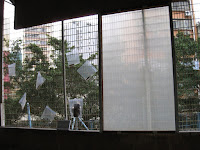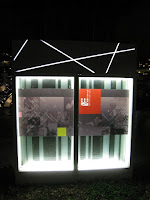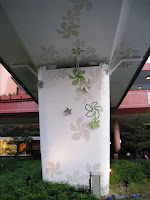






The original site of the Government Central School (44 Gough Street) and the original site of the Queen’s College (Aberdeen Street) are two checkpoints (No. 5 and No. 9) along Dr Sun Yat-Sen Historical Trail. People can only read their stories on the display boards outside of the School buildings, which are not open to public in normal days. I was always curious about the inside before.
http://www.heritage.gov.hk/tc/conserve/quarterssite.htm
http://www.lcsd.gov.hk/CE/Museum/sysm/download/leaflet_en_07.pdf
Fortunately, the Former Central School Envisioning Days come on 21, 22, 28/2/2009 & 1/3/2009. The Former Hollywood Road Police Quarters is transformed into Hollywood Road ART Qu
 arters. The quarters are made up of a higher block and a lower block with 3 platforms around. Kitchens on each floor are located in the common corridor, and people eat outside of their living rooms. Also, they have to share communal toilets and baths. The modern design of the quarters is not as magnificent as the Former Queen’s College, and the buildings are now shabby. However, the place is still charming as it is just full of stories and memories. Can you imagine a wonderful picture that some families are busy preparing dinner and some families are sitting around the dining table and enjoying the happy moment after a busy day? The quarters are then filled up with the smell of food and laughter.
arters. The quarters are made up of a higher block and a lower block with 3 platforms around. Kitchens on each floor are located in the common corridor, and people eat outside of their living rooms. Also, they have to share communal toilets and baths. The modern design of the quarters is not as magnificent as the Former Queen’s College, and the buildings are now shabby. However, the place is still charming as it is just full of stories and memories. Can you imagine a wonderful picture that some families are busy preparing dinner and some families are sitting around the dining table and enjoying the happy moment after a busy day? The quarters are then filled up with the smell of food and laughter.





Exhibits spread out in the two blocks where individual artists and art students are using the g
 round floor of the lower block and 14 participating galleries are grouped on the first floor of the upper block. Most of the installations are perfectly tuned to the old buildings and home environment. The theme of the artworks is interestingly related to home, school, old days, experiences, memories, vanishment, banishment, punishment, crime and prison, life and death, future…There are a lot of findings and fun in the tour.
round floor of the lower block and 14 participating galleries are grouped on the first floor of the upper block. Most of the installations are perfectly tuned to the old buildings and home environment. The theme of the artworks is interestingly related to home, school, old days, experiences, memories, vanishment, banishment, punishment, crime and prison, life and death, future…There are a lot of findings and fun in the tour.
Searching for the Missing:
Breeze
Video Installation
Choi Yan Chi

Be A Good Man/ Husband, Be A Good Woman/ Wife
Installation
Mok Yat San and Man Fung Yi

To begin with, there isn’t any matter
Paper / cotton fabric
anothermountainman

A Plague
Junk Wood Installation
Wong Tin Yan

Room in the sky
Installation
Kum Chi Keung

Towards a Brighter Future through the Valley of Darkness
Stickers, photographs, and waxed clothings
Kacey Wong


I’m not a curator, art loan from:
Luk Ching, Yvonne Cheng, Shirley Lee,
Lee Lee, Leo Wong, Elsa Wong, Boy Yiu
Installation
Lam Laam Jaffa

What are they watching?
Video show in the living room (provided by Jaffa Lam):
http://www.youtube.com/watch?v=aFW5q3bLgzo
Video show of the whole installation (provided by Jaffa Lam):
http://www.youtube.com/watch?v=tAUTcSD3WOY
Art Beatus Gallery:







1. Scar 02, 51 x 50cm
2. Scar 04, 50 x 54cm
3. Scar 07, 64 x 50cm
4. Scar 05, 64 x 50cm
5. Scar 01, 64 x 50cm
6. Scar 06, 64 x 50cm
7. Scar 08, 64 x 50cm
2008, plastic fabric, wire, ink drawing
Chan So Yee Pauline
The artist gives life to her drawings by using plastic fabric and wire effectively. Man’s inner physical situation and inner life are exposed to us thoroughly. What makes us feel happy, excited and nervous, hurt, painful and sick? Do we have enough supports? The bones are suffering from pressure; the blood vessels are dilating and constricting, and our skin is recording our everyday experiences. Dare you see yourself deeply?
Koru Contemporary Art:

Planet of the Bees, w 50 x h 50 x d 9cm
2003, carved, cast, laminated, glass
Bohumil Elias

Glass element with 8 Meduse, w 400mm x h 300mm x d 80mm
Glass element with 2 Cannocchie V, w 160mm x h 230mm x d 80mm
Glass element with 2 Squids, h 300mm
Alfred Barbini


Infinity #1, h 41 x w 136 x d 30cm
New Zealand demolition Kauri
Pigment stain / Oil & wax
Rick Swain
MOST:

Ghost College:
猛鬼學堂
2009, 混合媒界
譚逹強

改變用途Trasformazione
表演裝置記錄
劉中行

Trash to Treasure no. 3 – triangle
紙雕塑
陳美軒
Today, the Former Hollywood Road Police Quarters are being preserved because over 2,000 pieces of historical relics were found at the Site during the archaeological investigations between December 2005 and July 2007. The government intends to revitalize the Site as an attraction for local and overseas visitors, aligning the promotion of other heritage spots along Central and Western Heritage Trail – the Sheung Wan Route. As usual, economic benefits maybe its major concern, but I do hope the government will conform to what it mentioned, “…to provide quality city open space in the area. Due regard will be given to the preservation of the historical relics within and around the Site, the manifestation of its heritage value and original atmosphere.” Let’s wait and see!





































